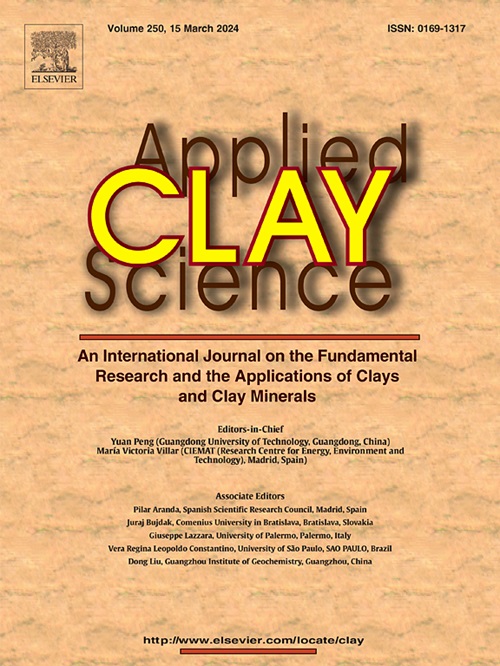受碱性羽流影响的臂架粘土的自密封能力:来自高分辨率x射线计算机断层扫描和水力导电性测量的证据
IF 5.8
2区 地球科学
Q2 CHEMISTRY, PHYSICAL
引用次数: 0
摘要
本研究旨在通过研究断裂的Boom Clay在与高碱性溶液相互作用后的水力导电性和矿物学变化的长期演变,评估受碱性羽流扰动时Boom Clay的自密封能力。首先,在未受扰动的粘土样品上,采用平行于顺层平面和垂直于顺层平面的Young Cement Water (YCW, pH = 13.5)和Evolved Cement Water (ECW, pH = 12.6)进行渗透实验。对这些碱性环境下的水力导电性(K)进行了估算,证实了之前的研究结果,由于Boom Clay的天然各向异性,其水平导电性高于垂直导电性。在第二步中,粘土样品被破碎。所有样品都经历了K的显著增加,随后逐渐减少,表明有效的自密封。利用x射线微计算机断层扫描和光谱微计算机断层扫描分析可视化了这种自密封过程。此外,还进行了矿物学分析,包括n2物理吸附比表面积和孔径分布、(定量)x射线衍射和傅里叶变换红外光谱分析。他们发现在YCW环境中蒙脱石部分溶解,但在ecw渗透样品中没有明显的矿物变化。死后试样的n2物理吸附实验表明,在所有研究案例中,比表面积都减小,微孔隙度也随之减小。虽然比表面积和微孔隙度的减小可以用YCW环境中蒙脱石的部分溶解来解释,但孔隙尺寸分布向大孔隙的转变可能与裂缝附近相对密度的变化和总体水力导率的增加有关。结果证实,即使长时间暴露在高ph条件下,Boom Clay也能保持其自密封能力。这项研究为Boom粘土的水力力学和矿物学反应提供了有价值的见解,对于评估其作为地质屏障的长期行为至关重要。本文章由计算机程序翻译,如有差异,请以英文原文为准。
Self-sealing capacity of boom clay affected by an alkaline plume: Evidences from high resolution X-ray computed tomography and hydraulic conductivity measurements
This study aims to evaluate the self-sealing capacity of the Boom Clay when perturbed by an alkaline plume, by investigating the long-term evolution of hydraulic conductivity and mineralogical changes in fractured Boom Clay upon interaction with highly alkaline solutions. In a first step, percolation experiments were conducted on undisturbed clay samples using Young Cement Water (YCW, pH of 13.5) and Evolved Cement Water (ECW, pH of 12.6), both parallel and perpendicular to bedding planes. Hydraulic conductivity (K) in these alkaline environments were estimated, confirming the previous studies, with higher horizontal than vertical hydraulic conductivity as a result of the natural anisotropy of the Boom Clay. In a second step, clay samples were fractured. All samples experienced a significant increase in K, followed by a progressive decrease, indicative of an efficient self-sealing. This self-sealing process was visualized using X-ray micro computed tomography and spectral micro computed tomography analysis.
In addition, mineralogical analyses, including specific surface area and pore size distributions from N2-physisorption, (Quantitative) X-ray diffraction and Fourier Transform Infrared spectroscopy analysis were conducted. They revealed partial dissolution of smectite in YCW environments but no significant mineral alteration in ECW-percolated samples. N2-physisorption experiments of the post-mortem samples indicated decrease of the specific surface area and concomitant decrease in the microporosity in all studied cases. Though the decrease in the specific surface area and microporosity can be explained by partial dissolution of smectite in the YCW environment, the shift of the pore size distribution towards larger pores can be linked to relative density changes in the vicinity of the fractures and overall increase in hydraulic conductivity. The results confirmed that Boom Clay retains its self-sealing capacity, even after prolonged exposure to high-pH conditions. This study provides valuable insights into the hydro-mechanical and mineralogical response of Boom Clay, essential for assessing its long-term behaviour as a geological barrier.
求助全文
通过发布文献求助,成功后即可免费获取论文全文。
去求助
来源期刊

Applied Clay Science
地学-矿物学
CiteScore
10.30
自引率
10.70%
发文量
289
审稿时长
39 days
期刊介绍:
Applied Clay Science aims to be an international journal attracting high quality scientific papers on clays and clay minerals, including research papers, reviews, and technical notes. The journal covers typical subjects of Fundamental and Applied Clay Science such as:
• Synthesis and purification
• Structural, crystallographic and mineralogical properties of clays and clay minerals
• Thermal properties of clays and clay minerals
• Physico-chemical properties including i) surface and interface properties; ii) thermodynamic properties; iii) mechanical properties
• Interaction with water, with polar and apolar molecules
• Colloidal properties and rheology
• Adsorption, Intercalation, Ionic exchange
• Genesis and deposits of clay minerals
• Geology and geochemistry of clays
• Modification of clays and clay minerals properties by thermal and physical treatments
• Modification by chemical treatments with organic and inorganic molecules(organoclays, pillared clays)
• Modification by biological microorganisms. etc...
 求助内容:
求助内容: 应助结果提醒方式:
应助结果提醒方式:


